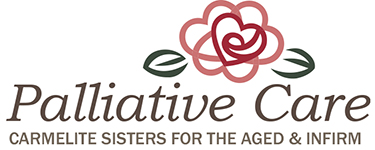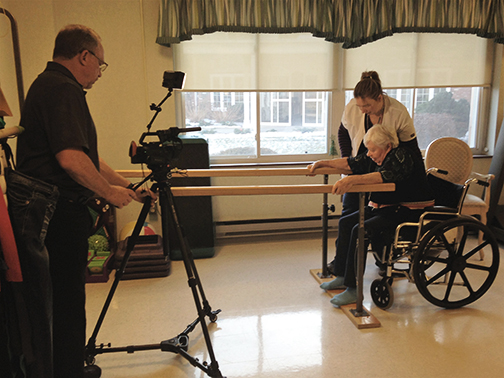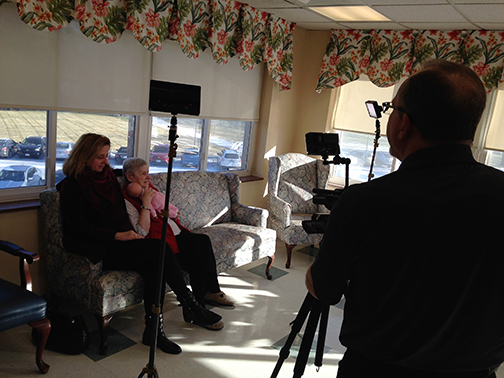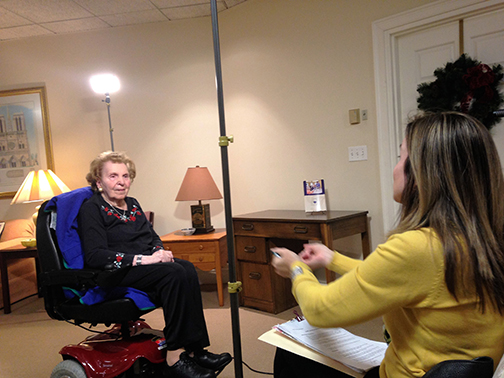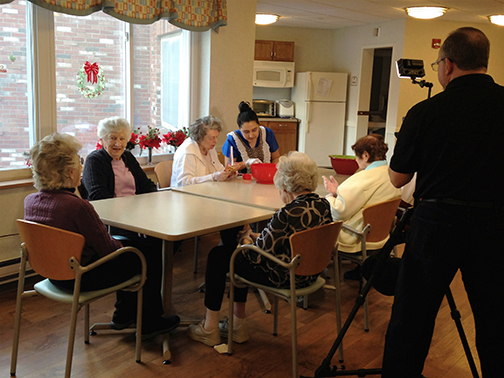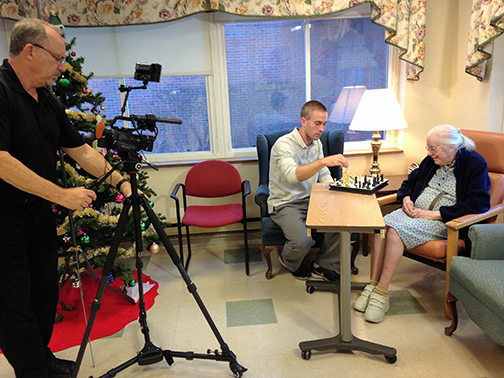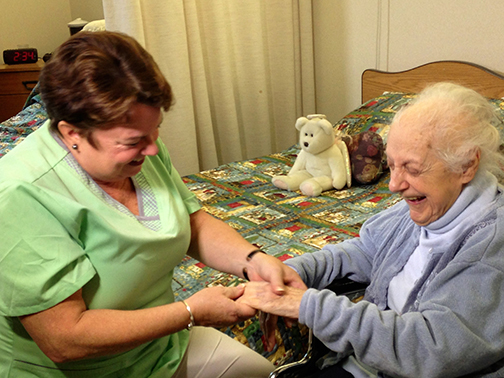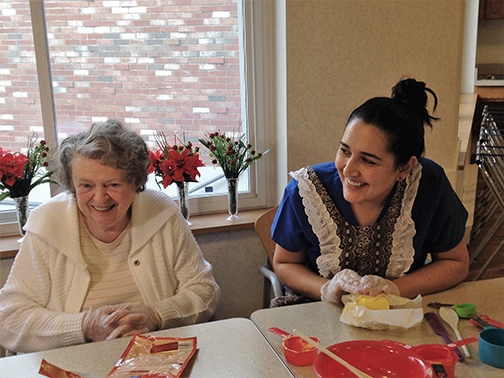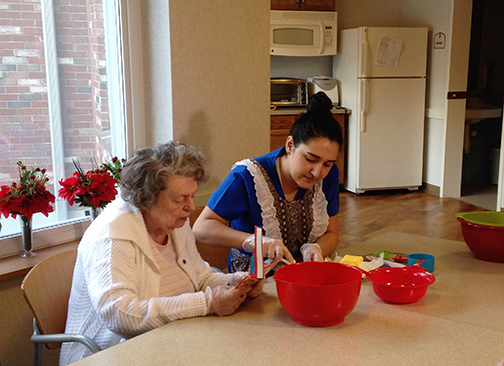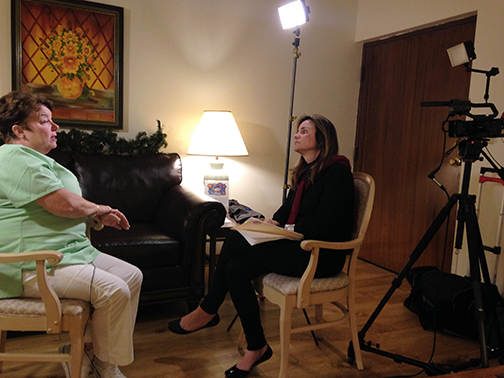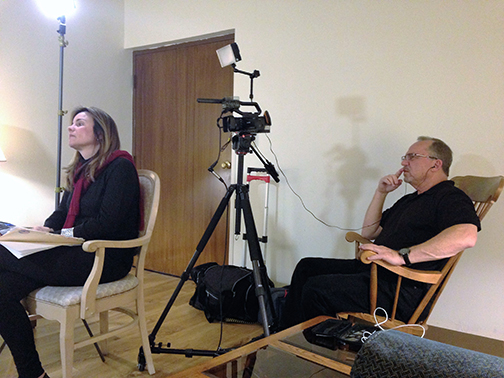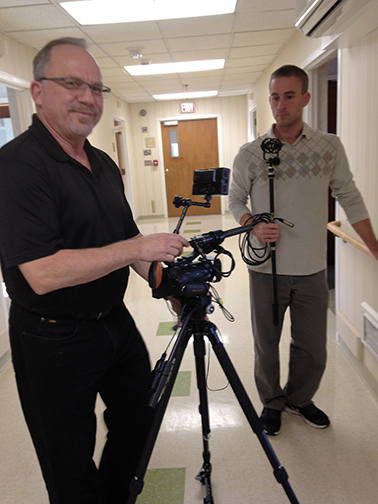News
Changing Lives in Columbus, Ohio

Picture this: a resident of a nursing home is no longer able to speak, yet he wears a mask of complacency because of Parkinson’s disease. He finds out that his brother, who lives in another state, died the previous week. The resident seems outwardly peaceful to the care staff, who do not know that he was very close to his brother. He deals with a broken heart and grief without any special comfort through the night and part of the next day. The staff are kind but unaware of his suffering.
This kind of scenario happens all the time in an average nursing home. Major events happen in residents’ lives, but a system ensuring that care staff know what is important to each resident is lacking. The above scenario happened at Mother Angeline McCrory Home in Columbus, Ohio, before the implementation of the Carmelite Palliative Care Program. Fortunately, two people found out by chance about the man’s grief the next day. One happened to be Sr. Winifred Jordan, a Palliative Care Nurse and Carmelite Sister, who alerted the rest of the staff to the resident’s devastating emotional, spiritual, and family pain so that they could comfort him. Every day since its implementation, the Palliative Care Program has brought lay staff to new levels of person-centered, teamwork-oriented care. The structure of the Program ensures that staff know their residents’ histories so they can share in their major life events and deliver special comfort care to every single resident.
“Palliative care is looking beyond the obvious and seeing what makes a person a person.” Every word that Sr. Winifred speaks is imbued with mission. Trained in the Carmelite philosophy of comfort care of the whole person begun by Venerable Mary Angeline McCrory in 1929, Sr. Winifred and Sr. Maureen Sullivan now train a staff of lay people to carry on that mission at Mother Angeline McCrory Home.
The palliative care team recognizes that excellent care comes from paying attention to details and knowing the people for whom you care. Whether ensuring that a resident who wants an extra pillow gets one, asking families for input, or running collaborative staff meetings, Sr. Winifred and Sr. Maureen have enthusiastically embraced training staff in palliative care and teaching them that care must go beyond the basics to see the unique person. Inclusion is important in Carmelite tradition. “What kind of community do we want? We want a house of love. How does that happen? Respect. And that’s where I focus all my energy.” The palliative care team is passionate that staff actively help residents be the best they can and want to be, help them adapt to change, and keep in touch with person inside.
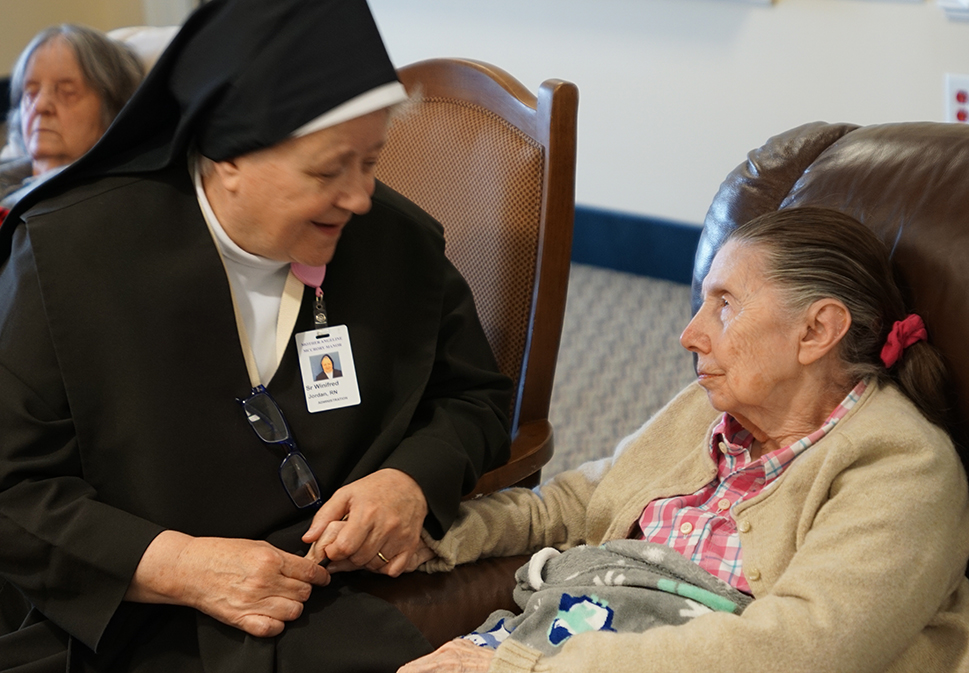
The Carmelite Palliative Care Program launched at Mother Angeline McCrory Home in August 2016, followed by a month of intensive education for the entire staff in September. At that time, the home was switching from paper to electronic computer systems while State inspections simultaneously took place. However, Sr. Winifred recognized the vital importance of implementing the Palliative Care Program and knew that it could not wait for another time. She accomplished the month of education by making staff education sessions a priority and striving to put them at the best possible time during staff members’ shifts, when they could concentrate instead of being busy or stressed.
The Program was introduced unit by unit throughout the nursing home. After training, staff was tested for competency and then, once staff testing was completed, they put the principles of the Program into action right away. While training happened, two Carmelite Sisters carried out pain assessments for all residents in the home. Physical pain assessments are standard in any care facility, but the Sisters also assessed residents for spiritual pain, emotional pain, family pain, and psychological pain (such as depression.) Every resident is re-assessed yearly and has a quarterly check-in screening. Additionally, Sr. Winifred filled out resident profiles that document what is important to each resident- family, jobs, history, places they have lived, nicknames, etc.- and put the profiles in a binder for all staff to study. This system ensures that staff can get to know the residents and treat them as individuals. Weekly team meetings are attended by staff from all areas of resident services- dining, housekeeping, maintenance, nursing, recreation, and social services. “They’re not only engaged, they’re excited,” Sr. Winifred reports.
This teamwork approach has enormous benefits for both staff and residents. Problems are brought to light, discussed, and solved. In one case, a resident with multiple serious illnesses called staff members to the room constantly to manage pain. The staff were unable to complete their other tasks and began to view this resident as troublesome and difficult. Bringing up the problem at a staff meeting led to several meetings with the resident to understand the source of the anxiety and negotiate a pain medication contract. The resident was able to choose how pain was managed and began to relax once the schedule went into place. The contract is adjusted as needed and the resident continues to remain comfortable. The look of constant pain is gone, and the resident now has control over management of the pain. Sr. Winifred said that everyone feels much more positive after implementing the contract. “It shows the residents that they are listened to, that they are important, that their care is important, and that we don’t want them to suffer. It was also important for staff to know that their schedules were important, and that by working as a team we can have things happen so it doesn’t turn into and ‘us-against-him’ sort of response.”
Sr. Winifred also reports that staff members are greatly benefitting from the Palliative Care Program. They understand that the administration is on their side and they are regularly consulted for input on problem-solving. The principles of the Carmelite Palliative Care Program have been effective at Mother Angeline McCrory home, and Sr. Winifred’s hard work to collaborate with staff for the residents’ benefit has yielded tangible results. More stories featuring the Palliative Care Program in action can be seen here.
An Interview with Staff at St. Patrick’s Manor in Framingham, MA
Recently, Stacey Sumereau of the Avila Institute of Gerontology interviewed Sr. Maureen McDonough, Administrator, and Geri Gracey, Clinical Instructor, at St. Patrick’s Manor in Framingham, Massachusetts. St. Patrick’s Manor is one of the six pilot homes where the Carmelite Palliative Care Program was pioneered starting in 2012. You can see stories of the staff, residents and families whose lives have been changed by the Palliative Care Program at St. Patrick’s Manor. Stacey wanted to better understand the process and the challenges that the St. Patrick’s Manor team needed to overcome in order to establish a strong palliative care program.
Q: Can you give me a quick summary of how the care has changed since the palliative care program was first implemented?
Geri: Staff know the residents better. I hear that, especially from the nursing assistants. The residents have a better connection with the care team. During palliative care meetings we review the resident life history, preferences and domains of pain so that the care team can get to know the resident better and provide compassionate and holistic care. The care team is much more aware of the resident’s’ preferences, they are able to recognize and understand the resident’s wants and needs.
Q: What effect have you seen on the residents with the Palliative Care Program?
Sr. Maureen: We have seen a varying effect based on the resident’s individual situation but overall we have seen many improvements in the residents from our palliative program. Many residents have benefited from the socialization and the security of their new surroundings. Residents enjoy attending activities and socialization in the Main Dining Room. The outcome has been beneficial for the resident as well as the team.
Q: I imagine it must have been a lot of work to implement the Program- for example using the profile assessments, and a whole new structure for the staff. How much work did it actually take?
Geri: It was a lot of work. We’ve been at it now for four years, and what people have to understand is not to try to go too fast. You have to really think about what you’re doing, set up programs, focus on education, and make sure that everyone is really on board with what it is. We have to be patient and stay focused on the goals of the program. We have to continue to work together as a team and help the team understand the benefits of providing person-centered and palliative care for our residents.
Sr. Maureen: It’s important that your steering committee works together. We meet weekly as a team to go over the ways that we can improve our program and processes. We find that we need to have ongoing education and communication with our medical staff, care teams, residents and families about the program.
Geri: Yes, each of us on the steering committee attends the palliative care meeting on each unit. You really have to keep on top of it to keep the team focused and committed on the resident and any issues that may arise.
Q: How do you overcome the lack of knowledge of palliative care with the families of the residents? I know palliative care is often confused with hospice care.
Geri: I’m really impressed with the way the Admissions, Social Services and the Nursing departments introduce it to the family members. It’s very nicely done. They get the brochure as soon as they come into the home.
Sr. Maureen: The brochure explains our philosophy, and then we talk to them and answer any questions they may have. Most residents come to us on medications so we try to explain that the reasons that they are on the medication is to treat their medical condition which is a palliative measure. A lot of people are on palliative care but don’t realize it. They get that explanation right up front, and then people are talking about it right at admission and it continues throughout their stay.
Q: Were there challenges getting the staff to adopt this new way of thinking?
Geri and Sr. Maureen: The Carmelite Sisters’ philosophy has always taught us the concept of palliative care. The challenge of formalizing the program has been the education needed and getting staff to understand the importance of documentation. We needed to change their routine and mindset. Now that the program has been implemented the care team has been able to see the benefits, rewards and how this program supports our mission.

Making of the Palliative Care Video
On December 13, 2016, five people loaded up a car in the freezing December weather and trekked from New York to Framingham, MA, to encounter and document the groundbreaking Carmelite Palliative Care Program at St. Patrick’s Manor. Since 2012, this unique Program has been changing the lives of residents, families, and staff, and the crew members were eager to hear about their experiences. The time has come to expand and publicize this new and much-needed approach to palliative care, which you can read about in more detail here.
Linda Corley, producer of the 2014 Reality Docu-Series The Sisterhood: Becoming Nuns, which followed five young women as they considered entering the Carmelite Sisters community, came from Florida to produce the video with cameraman Joel Kaplan. She and Joel each bring over 30 years of experience as documentarians with established giants such as PBS and National Geographic. Stacey Sumereau, who was one of the five young women featured on The Sisterhood and now works for the Avila Institute, co-produced the video with Linda. Her husband, John Sumereau, served as grip for the project, and Sr. Peter Lillian, director of the Avila Institute of Gerontology, served as advisor and overseer of the process.
In three intense days of filming, the five crew members conducted interviews with four family members, three residents, three staff members, and two Sisters. In addition to hearing their spoken testimonies about how the Palliative Care Program has changed their lives and the lives of their loved ones, the challenge for the camera crew was to bring those testimonies to light visually. One family member raved about the staff member who brought her 103-year-old mother a new pink sweater because “she thought it would look pretty on her.” Working in a visual medium, the crew needed to capture footage of that staff member helping the mother into the pink sweater.
In a project like this, much of the planning had to happen on the spot. The schedule of interviews was established beforehand, but beyond that, the crew had to act out what the interviewees discussed. Karla Diaz, one of the CNA’s, said she enjoyed caring for the residents as she would for her mother or father who live far away. That comment necessitated filming her interacting with her residents — filing one’s nails and wiping away another’s tears. Cindy Dion mentioned specific things the staff does, such as baking on the floors to produce a homelike atmosphere, so the crew made sure to drop in on an afternoon baking club. Although capturing those touching moments may sound simple, it took a lot more time than you might expect. Ensuring the lighting was adequate, removing distracting objects from the background, obtaining resident permissions to be filmed, and ensuring that the surrounding area remained quiet was an involved process. Working within everyone’s time constraints was sometimes difficult too; it led to twelve-hour days, filming Sr. Peter’s and Sr. Maureen’s interviews until 9 p.m. At times, it felt like a race against the clock.
Emotional, mental, and psychiatric pain are all internal and are therefore are difficult to show on camera. Linda and Joel came up with creative, visually interesting ways to show that the residents at St. Patrick’s are thriving. They filmed residents reminiscing over pictures from their past or doing physical therapy, and the crew paced up and down the hallways of the extensive nursing home garnering shots of Sisters hugging and kissing the residents, staff making cookies and holding hands with residents, and many other moments of authentic human connection that helped highlight the hallmarks of palliative care on film. Joel and Linda edited the videos post-filming once home in Florida and produced seven testimonies, a three-minute overview, and a thirteen-minute video within three months.
The sense of family that pervaded every floor was palpable. As Karla Diaz, who has worked at St. Patrick’s for three years, said, “It makes me feel good inside, because I know that I am doing something for someone who really needs it. There are some residents who have a lot of family to come visit them, but there are some people who don’t have any. And you have to be there for them more.” After capturing beautiful stories that will help launch the program into the public eye, the videos are the main feature of this website. This website is intended for residents, staff and families to learn about palliative care.
